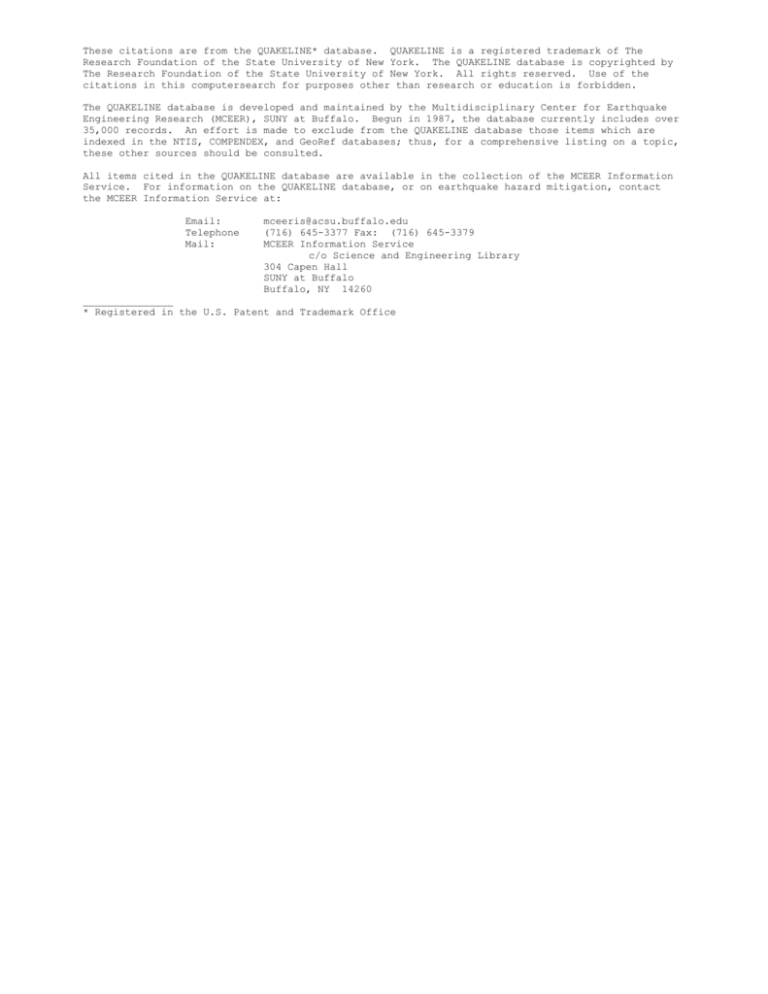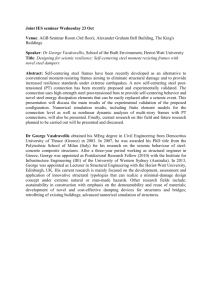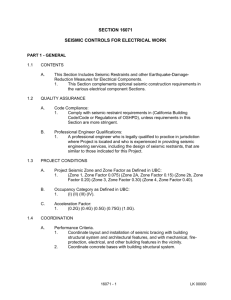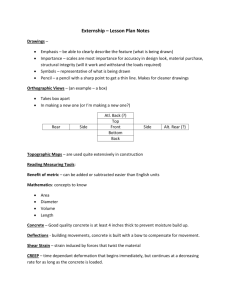
These citations are from the QUAKELINE* database. QUAKELINE is a registered trademark of The
Research Foundation of the State University of New York. The QUAKELINE database is copyrighted by
The Research Foundation of the State University of New York. All rights reserved. Use of the
citations in this computersearch for purposes other than research or education is forbidden.
The QUAKELINE database is developed and maintained by the Multidisciplinary Center for Earthquake
Engineering Research (MCEER), SUNY at Buffalo. Begun in 1987, the database currently includes over
35,000 records. An effort is made to exclude from the QUAKELINE database those items which are
indexed in the NTIS, COMPENDEX, and GeoRef databases; thus, for a comprehensive listing on a topic,
these other sources should be consulted.
All items cited in the QUAKELINE database are available in the collection of the MCEER Information
Service. For information on the QUAKELINE database, or on earthquake hazard mitigation, contact
the MCEER Information Service at:
Email:
Telephone
Mail:
mceeris@acsu.buffalo.edu
(716) 645-3377 Fax: (716) 645-3379
MCEER Information Service
c/o Science and Engineering Library
304 Capen Hall
SUNY at Buffalo
Buffalo, NY 14260
_______________
* Registered in the U.S. Patent and Trademark Office
POST-TENSIONING IN STEEL CONNECTIONS
Computer search in the QUAKELINE® Database (10 records)
Performed by S. Salisbury
September 2002
QUAKELINE DATABASE 1987 - JULY 2002
1
2
3
AN
AU
TI
SO
LO
NU
NT
ID
AB
AN
AU
TI
SO
LO
NU
NT
_:POST ADJ TENSION$3
_:1 SAME STEEL
_:2 SAME CONNECTION$1
93 docs
31 docs
10 docs
Document 1 of 10
2001-0990.
Shen, Qiang. Kurama, Yahya C.
LATERAL LOAD BEHAVIOR OF UNBONDED POST-TENSIONED HYBRID
COUPLED WALLS.
Composite and Hybrid Structures: Proceedings of the Sixth
ASCCS International Conference on Steel-Concrete Composite
Structures; Los Angeles, CA, March 22-24, 2000. Xiao, Y and
Mahin, S A, eds. ASCCS-6 Secretariat, Department of Civil
Engineering, University of Southern California, Los Angeles, CA,
2000, volume 2, pages 793-800.
SEL TA664.A83 2000 v.2.
ISBN: 0-9679749-0-9. GRANT: NSF CMS-98-10067.
4 references. Graphs, diagrams. Research funded by the
National Science Foundation. Keynote paper. Proceedings of the
6th ASCCS International Conference on Steel Concrete Composite
Structures.
Unbonded walls. Hybrid walls. Coupled walls. Post
tensioned steel. Coupling beams. Lateral loads. Seismic
behavior. Seismic design. Nonlinear rotation. Stiffness.
Ultimate strength. Embedded beams. Beam to wall connections.
Flange plates. Cover plates. Compressive yielding. Seat angles.
Inelastic behavior. Energy dissipation. Nonlinear analysis.
Static analysis. Dynamic analysis. Time history analysis.
DRAIN-2DX. Monotonic loading. Cyclic loads. Force ratios.
Multistory structures. Concrete walls. Analytical models.
This paper describes an ongoing research program at the
University of Notre Dam on the seismic behavior and design of
unbonded post-tensioned hybrid coupled walls. Concrete walls are
coupled using steel beams and unbonded post-tensioning without
embedding the beams into the walls. Analytical results indicate
that unbonded post-tensioned steel coupling beams can be designed
to soften and undergo large nonlinear rotations of up to 7.5
percent without significant permanent residual rotations upon
unloading. These beams have similar stiffness and ultimate
strength as embedded steel coupling beams. Nonlinear rotations in
the beams occur primarily through gap opening along the beam-towall connections. Flange cover plates are used to delay the
yielding of the beams in compression. Top and bottom seat angles
are used at the beam-to-wall connections to provide inelastic
energy dissipation. (Adapted from authors' abstract).
Document 2 of 10
2001-0981.
Peng, Shih-Wei. Ricles, James M. Sause, Richard. Lu, LeWu.
EXPERIMENTAL EVALUATION OF A POST-TENSIONED MOMENT
CONNECTION FOR STEEL AND COMPOSITE FRAMES IN SEISMIC ZONES.
Composite and Hybrid Structures: Proceedings of the Sixth
ASCCS International Conference on Steel-Concrete Composite
Structures; Los Angeles, CA, March 22-24, 2000. Xiao, Y and
Mahin, S A, eds. ASCCS-6 Secretariat, Department of Civil
Engineering, University of Southern California, Los Angeles, CA,
2000, volume 2, pages 721-728.
SEL TA664.A83 2000 v.2.
ISBN: 0-9679749-0-9. GRANT: NSF CMS 9396120. NSF CMS
9520279.
2 references. Graphs, tables, diagrams. Research funded by
National Science Foundation. Keynote paper. Proceedings of the
6th ASCCS International Conference on Steel Concrete Composite
ID
AB
AN
AU
TI
SO
LO
NU
NT
ID
AB
AN
AU
TI
SO
LO
NU
NT
ID
Structures.
Composite frames. Steel moment resisting frames. Moment
connections. Seismic behavior. Steel beams. Wide flange (WF)
beams. Cyclic strength. Ductility. Elastic behavior. Moment
capacity. Energy dissipation. Design models. Post tensioned
(PT) steel connections. Flexural behavior. Decompression.
Lateral load displacement. Hysteretic response. Stiffness.
Comparative studies. Top and seat connections. Parametric
analysis. Yielding.
An experimental study was conducted to investigate the
seismic behavior of an innovative moment connection for steel
moment resisting frames. The connection consists of bolted top
and seat angles with post-tensioning strands. The experimental
program involved the testing of nine large-scale specimens. Each
specimen represented an interior connection, consisting of two
wide flange (WF) steel beams attached to a column. Several
parameters were investigated in the study: angle leg thickness,
angle gage length, beam flange reinforcement plates, connection
shim plates, and post-tensioning force. The results of the test
program demonstrate that post-tensioned connections possess
exceptional cyclic strength and ductility, where yielding occurs
in the angles while other structural members remain essentially
elastic. The initial elastic stiffness of the connection is
comparable to that of a conventional fully restrained connection,
with no permanent deformation occurring in the specimen following
the application of several inelastic cycles of drift. The angle
geometry is shown to influence the connection moment capacity and
energy dissipation. Simple design models for estimating
connection behavior are presented and compared to the test
results. (Adapted from authors' abstract).
Document 3 of 10
2001-0570.
Cheok, Geraldine S. Lew, H S.
SIMPLIFIED DESIGN PROVISIONS FOR HYBRID PRECAST CONNECTIONS.
Proceedings of the 29th Joint Meeting of US-Japan Panel on
Wind and Seismic Effects, UJNR; Tsukuba, Japan, May 13-16, 1997.
Okahara, Michio, ed. [Public Works Research Institute, Tsukuba,
Japan], 1997, pages 149-160.
SEL TA654.5.U55 1997.
ISSN: 0386-5878.
5 references. Graphs, diagrams. Series: Technical
Memorandum of the Public Works Research Institute number 3524.
Proceedings of the Twenty-ninth Joint Meeting of US-Japan Panel on
Wind and Seismic Effects.
Hybrid connections. Precast connections. Beam column
connections. Moment connections. Simplified design provisions.
Earthquake resistant design.
A rational design procedure is presented to compute the
probable moment, the nominal moment, and the story drift
capacities of a hybrid precast moment-resisting beam-to-column
connection. The hybrid connections consist of mild steel that is
used to dissipate energy by yielding and high strength
prestressing steel which is used to provide the shear resistance
through friction developed at the beam-column interface by the
post-tensioning force. The design procedure is based on 1/3-scale
hybrid precast beam-to-column connections tested at the National
Institute of Standards and Technology (NIST). The simplified
procedure relies on the stress-strain behavior of mild steel up to
its ultimate strength and is based on equilibrium considerations
at the beam-column joint. (Authors' abstract).
Document 4 of 10
2001-0354.
Garlock, M M. Ricles, J M. Sause, R. Zhao, C. Lu, L W.
SEISMIC BEHAVIOR OF POST-TENSIONED STEEL FRAMES.
Behaviour of Steel Structures in Seismic Areas: Proceedings
of the Third International Conference: STESSA 2000; Montreal,
Canada, August 21-24, 2000. Mazzolani, Federico and Tremblay,
Robert, eds. A A Balkema, Rotterdam, Netherlands, 2000, pages
593-599.
SEL TA684.S767 2000.
ISBN: 90-5809-130-9.
13 references. Graphs, diagrams. Proceedings of the 3rd
International Conference: STESSA 2000.
Seismic behavior. Seismic performance. Post tensioned
steel frames. Earthquake resistant design. Steel moment
AB
AN
AU
TI
SO
LO
NU
NT
ID
AB
AN
AU
TI
PB
LO
NU
NT
ID
AB
resisting frames. Connections. Ductility. Multistory buildings.
Energy dissipation. Strength.
A post-tensioned connection for earthquake resistant steel
moment resisting frames (MRFs) is introduced. The connection has
excellent ductility, limits inelastic deformations to the easily
replaceable components of the connection, requires no field
welding, and returns the structure to its pre-earthquake position.
The connection includes bolted top and seat angles with posttensioned high strength strands running parallel to the beam.
Analyses were performed on a six-story, six-bay post-tensioned
steel MRF to study its response to strong ground motions. Results
show good energy dissipation, strength, and ductility in the posttensioned system. The analyses indicate that the seismic
performance of a post-tensioned steel frame can exceed that of a
frame with conventional moment resisting connections. (Authors'
abstract).
Document 5 of 10
2001-0309.
Ricles, J M. Sause, R. Garlock, M M. Peng, S W. Lu, L W.
EXPERIMENTAL STUDIES ON POST-TENSIONED SEIMSIC RESISTANT
CONNECTIONS FOR STEEL FRAMES.
Behaviour of Steel Structures in Seismic Areas: Proceedings
of the Third International Conference: STESSA 2000; Montreal,
Canada, August 21-24, 2000. Mazzolani, Federico and Tremblay,
Robert, eds. A A Balkema, Rotterdam, Netherlands, 2000, pages
231-238.
SEL TA684.S767 2000.
ISBN: 90-5809-130-9.
7 references. Graphs, tables, diagrams. Proceedings of the
3rd International Conference: STESSA 2000.
Steel frames. Seismic resistant connections. Earthquake
resistant design. Beam to column moment connections. Parametric
studies. Angle size. Gage length. Beam flange reinforcing
plates. Post tensioning forces. Ductility. Cyclic strength.
Energy dissipation. Stiffness.
A series of experimental tests were conducted to investigate
the behavior of an innovative post-tensioned (PT) top-and-seatangle wide flange (WF) beam-to-column moment connection for steel
moment resisting frames subjected to seismic loading conditions.
Nine large-scale specimens were tested. Each specimen represented
an interior connection and consisted of two WF beams attached to a
column. The parameters investigated in the study include the
angle size, angle gage length, beam flange reinforcing plates,
connection shim plates, and post-tensioning force. The results of
the test program demonstrate that post-tensioned connections
possess exceptional cyclic strength and ductility. Energy
dissipation occurs in the angles while other structural members
remain elastic. The initial elastic stiffness is comparable to
that of a welded connection, and following severe inelastic cycles
of drift the connection has little permanent deformation. The
angle parameters are shown to influence the connection moment
capacity and energy dissipation. (Adapted from authors'
abstract).
Document 6 of 10
2000-0061.
El-Sheikh, M. Sause, R. Pessiki, S. Lu, L-W. Kurama, Y.
SEISMIC ANALYSIS, BEHAVIOR AND DESIGN OF UNBONDED POSTTENSIONED PRECAST CONCRETE FRAMES.
Department of Civil and Environmental Engineering, Lehigh
University, Bethlehem, PA, 1998.
SEL TA683.7.S43 1998.
REPORT: PRESSS-98-04. LU-EQ-97-02. GRANT: NSF BCS9307880.
316 pages. 71 references. Graphs, tables, diagrams.
Research funded by the National Science Foundation as part of the
Precast Seismic Structural Systems (PRESSS) research program.
Precast concrete frames. Post-tensioned frames. Seismic
analysis. Unbonded post-tensioned connections. Beam-column
connections. Seismic behavior. Earthquake resistant design.
Flexural behavior. Ductile connections. Nonlinear elastic
systems. Shear resistance. Shear behavior. Beam column
subassemblages. Moment rotation behavior. Analytical models.
Pushover analysis. Dynamic time history analysis. Nonlinear
response.
The report investigates the seismic behavior of unbonded
post-tensioned frames analytically. The behavior of these frames
is controlled by gap opening along the interface between the
beams and columns. An analytical model for unbonded posttensioned beam-column subassamblages and frames, based on fiber
beam-column elements, is developed and correlated with tests
results. The report proposes a seismic design approach for
unbonded post-tensioned beam-column connections and frames.
Under a design level ground motion, the following behavior is
expected: 1) nonlinear flexural behavior in the beam-column
connections; 2) cover spalling in the connections; 3) no yielding
of the post-tensioning steel in the beams; and 4) yielding of the
columns at the base. Under a survivability level ground motion,
the following behavior is expected: 1) yielding of the posttensioning steel in the beams, but no fracture of the steel; 2)no
crushing of concrete in the beam-column connections; and 3) no
shear slip at the beam-column interface. Using the proposed
design approach, four prototype frames have been designed. The
report provides an in-depth discussion of the seismic response of
the prototype frames, based on the results of a large number of
push-over static analyses and nonlinear dynamic time-history
analyses. (Adapted from authors' abstract).
AN
AU
TI
SO
LO
NU
NT
ID
AB
AN
AU
TI
SO
LO
NU
NT
ID
AB
Document 7 of 10
1997-1826.
Cheok, Geraldine S. Stone, William C. Lew, H S.
SEISMIC PERFORMANCE BEHAVIOR OF PRECAST CONCRETE BEAM-COLUMN JOINTS.
Structural Engineering in Natural Hazards Mitigation: Proceedings of
Papers Presented at the ASCE Structures Congress '93; Irvine,
California, April 19-21, 1993, volume 1, pages 83-88.
SEL TA654.6.S87 1993 v.1.
ISBN: 0-87262-910-4.
4 references. Graphs, diagrams.
Precast concrete connections. Beam column connections. Dynamic
response. Seismic zone 2. Seismic zone 4. Cyclic inelastic loads.
Failure modes. Displacement ductility. Strength. Energy
absorption.
The experimental test program being conducted at the National
Institute of Standards and Technology on 1/3 scale model precast
concrete beam-to-column connections is summarized. The objective of
the test program is to develop guidelines for an economical precast
beam-to-column connection for regions of high seismicity. The test
specimens were interior connections designed using the Uniform
Building Code criteria for seismic zones 2 and 4 as guidelines. To
date, fifteen specimens have been tested. Variables in the study
include location of the post-tensioning steel, the use of
post-tensioning bars versus prestressing strand, fully bonded versus
partially bonded strands, and the combination of low strength steel
and post-tensioning. Specimens were subjected to reversed cyclic
loading according to a prescribed displacement history. Comparisons
were made between the behavior of precast specimens and monolithic
specimens. The comparisons were based on connection strength,
connection ductility, and energy absorption characteristics.
(Authors' abstract).
Document 8 of 10
1995-2367.
Stone, William C. Cheok, Geraldine S. Stanton, John F.
PERFORMANCE OF HYBRID MOMENT-RESISTING PRECAST BEAM-COLUMN CONCRETE
CONNECTIONS SUBJECTED TO CYCLIC LOADING.
ACI structural journal, volume 92, number 2, March-April 1995, pages
229-249.
SEL Per TA680.A25.
ISSN: 0889-3241.
16 references. Diagrams, tables, graphs, photographs. Partial
funding provided by the Concrete Research and Education Foundation
of the American Concrete Institute. ACI title number 92-S22.
Beam column frames. Concrete construction. Cyclic loads.
Earthquake resistant structures. Joints. Moments. Post
tensioning. Precast concrete. Hybrid connections. Seismic design
guidelines. Steel. Shear. Energy dissipation. Connection
strength. Drift capacity. Building codes. Beam column
connections. Precast connections. Uniform Building Code (UBC).
Prestressing. Precasting.
Test results of 10 hybrid precast concrete beam-to-column
connections are presented. These tests constitute part of an
experimental program on one-third scale model precast
moment-resisting connections. The objective of the test program is
to develop guidelines for the design of moment-resisting precast
connections in regions of high seismicity. The hybrid connections
consist of mild steel used to dissipate energy and post-tensioning
(PT) steel used to provide the required shear resistance. Variables
examined were the amount and type of mild steel (ASTM A615). The
amount of post-tensioning steel was varied to control the relative
moment capacity contributed by the PT and mild steel. The specimens
were subjected to reversed cyclic loading in accordance with a
prescribed displacement history. Connection performances were
compared to previous NIST tests based on energy dissipation
capacity, connection strength, and drift capacity. (Adapted from
authors' abstract).
AN
AU
TI
SO
LO
NU
NT
ID
AB
AN
AU
TI
SO
LO
NU
NT
ID
AB
Document 9 of 10
1995-1230.
Martinez Cruzado, Jose A. Qaisrani, Allah N. Moehle, Jack P.
POST-TENSIONED FLAT PLATE SLAB-COLUMN CONNECTIONS SUBJECTED TO
EARTHQUAKE LOADING.
[Proceedings of the] Fifth US National Conference on Earthquake
Engineering; July 10-14, 1994, Chicago, Illinois. Earthquake
Engineering Research Institute, Oakland, CA, 1994, volume II, pages
139-148.
SEL QE531.U7 1994 v.2. EERC 400/U823/1994/v.2.
ISBN: 0-943198-46-1.
7 references. Graphs, tables, diagrams. Research funded by the
National Science Foundation. 5th US National Conference on
Earthquake Engineering. 5NCEE.
Post tensioned slab column connections. Flat plate connections.
Seismic loads. Repaired connections. Stiffness. Strength.
Deformability. Post failure response. Failure modes. Interior
connections. Lateral load. Biaxial loads. Post tensioned flat
plates.
Four interior, two edge, and two corner post-tensioned slab-column
connections were tested at reduced scale under simulated biaxial
earthquake loading. The connections were modeled after a prototype
slab designed for gravity load only. The tendons in the slab were
banded in one direction and uniformly distributed in the orthogonal
direction, and mild steel was provided to satisfy the requirements
of the ACI Building Code. Both original conditions, and repaired
and retrofit conditions, were investigated. The test results
provide direct measure of the stiffness, strength, deformability,
and post-failure response of this type of construction. Efficacy of
various retrofit and repairs strategies is also identified.
(Authors' abstract).
Document 10 of 10
1995-0191.
Cheok, Geraldine S. Lew, H S.
MODEL PRECAST CONCRETE BEAM-TO-COLUMN CONNECTIONS SUBJECT TO CYCLIC
LOADING.
PCI Journal, volume 38, number 4, July/August 1993, pages 80-92.
SEL Per TA680.P83.
ISSN: 0887-9672.
9 references. Graphs, photographs, diagrams. Journal of the
Prestressed Concrete Institute.
Precast concrete. Model tests. Beam column connections. Cyclic
loads. Post-tensioning steel. Partially bonded strands. Fully
bonded strands. Prestressing strands. Strength. Ductility.
Energy dissipation.
Experimental results of eight 1/3-scale model precast concrete
beam-to-column connections are presented. The test specimens
consisted of interior connections designed in accordance with the
1985 Uniform Building Code provisions for Seismic Zones 2 and 4.
These tests constitute the second and third phases of a multi-year
test program being conducted at the National Institute of Standards
and Technology. The objective of the test program is to develop
guidelines for an economical precast beam-to-column connection for
regions of high seismicity. Variables considered in the research
program include location of the post-tensioning steel, the use of
post-tensioning bars vs prestressing strands and fully bonded vs
partially bonded strands. Specimens were subjected to reversed
cyclic loading according to a prescribed displacement history.
Comparisons were made between the behavior of precast concrete
specimens and the monolithic specimens tested previously in Phase I.
These comparisons were based on connection strength, ductility and
energy dissipation characteristics. Comparison of results with the
monolithic test specimens indicates that the post-tensioned precast
concrete specimens had comparable connection strengths, higher
ultimate displacement ductilities and total energy dissipation to
failure, but lower energy dissipation per cycle. (Authors'
abstract).
END OF DOCUMENTS IN LIST






